[ad_1]
Nuthawut Somsuk/iStock via Getty Images
Thesis
Both the Global X Russell 2000 Covered Call ETF (BATS:RYLD) and Global X NASDAQ 100 Covered (NASDAQ:QYLD) ETF funds follow a covered-call strategy. The difference is that RYLD’s underlying is the Russell 2000 index, and the QYLD’s underlying is the NASDAQ 100 index. Both have been making attractive monthly distributions since their inception (QYLD was launched about 8 years ago and RYLD about 3 years ago). Both generate their generous monthly distributions by writing covered calls, as explained by the fund description:
- The RYLD fund gains exposure to the stocks in the Russell 2000 and simultaneously sells a call option on the Russell 2000 index. The fund collects the premium received from selling this option in exchange for forfeiting the upside appreciation of the Russell 2000.
- QYLD follows a similar approach. Its covered call position is created by buying (or owning) the stocks in the Nasdaq 100 Index (NDX) and selling a monthly at-the-money index call option
- RYLD/QYLD seeks to generate income through covered call writing, which historically produces higher yields in periods of volatility.
The emphases were added by me and they will be the fine prints that this article will examine in more depth. Furthermore, despite their similarities, there are subtle differences between RYLD and QYLD that investors should be aware of to make informed decisions. A summary of the highlights before we dive into the details:
- Currently, both funds are attractive. They are both generating high dividend yields (13.76% for RYLD and almost 15% for QYLD). Such dividend yields are not high in absolute terms, but also among the highest levels when compared to their own historical record and the current risk-free interest rates.
- Furthermore, QYLD features an even thicker yield spread than RYLD, which makes it even more attractive in our view.
- Finally, as the fund description disclosed, the use of covered-call options is at the price of forfeiting the upside appreciation. And investors need to be aware of this limitation. How much a disadvantage depends on your goal and investing style, as we will explore in detail.
RYLD and QYLD: Basic information
The following two charts summarize the base basic information of these funds for readers who are not familiar with them yet. Both are issued by Global X, and RYLD is the relatively smaller fund here with total assets of about $1.29B, in contrast to over $6.8B for QYLD. As a result, RYLD’s trading volume is also substantially lower. On average, about $23M worth of RYLD shares changes hands daily, compared to $124M for QYLD. But both RYLD and QYLD charge the same expense ratio of 0.6%. And also, both trades with the same tight spread. The average trading spread has been about $0.01 for both funds or about 0.05% in relative terms for both of them. As a result, I do not suggest most investors be concerned about their size or liquidity.
The second chart compares their specific holdings. As seen, the largest holding in the RYLD fund is the Vanguard Russell 2000 ETF, almost half of its total assets. In total, it holds 2011 holdings in the small-cap space. In contrast, the holdings in QYLD mimic the NASDAQ 100 with familiar names like Apple, Microsoft, Google, et al.
And in both cases, these holdings are used to “cover” the calls that the funds write, as to be elaborated next.
Source: ETF.com Source: ETF.com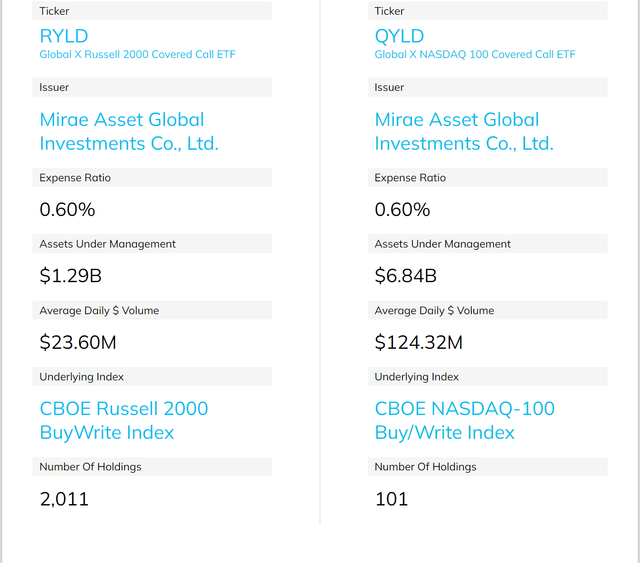
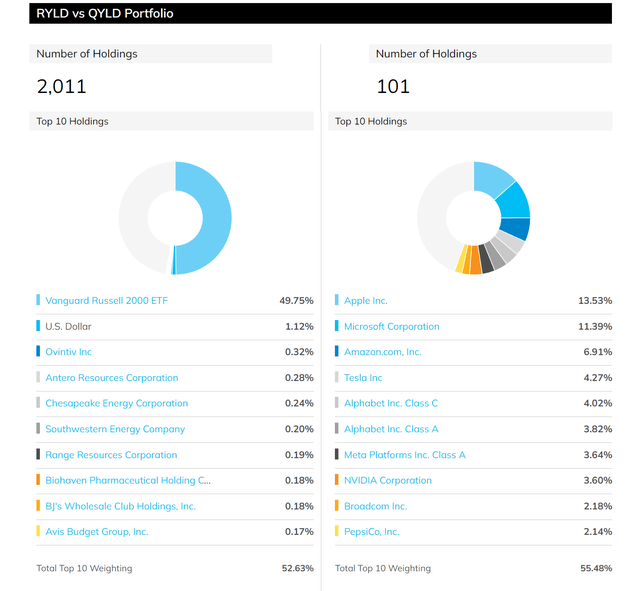
RYLD and QYLD advantage 1: excellent income and hedge
As can be seen from the following chart, both the RYLD and QYLD fund provided consistently high dividend income relative to the underlying index (represented by IWM and QQQ, respectively). Since 2020, both RYLD and QYLD have been steadily yielding 10%+. Currently, RYLD yields 13.7%, more than 410 basis points above its four-year average yield of 9.5%. QYLD yields even more, almost 15%. Compared with its four-year average of around 8.5%, its current yield a whopping 650 basis points higher. And when compared to the yield from the underlying index such as IWM and QQQ (which yields about 1.11% and 0.55%, respectively), the contrast is even more dramatic. And such dramatic differences in yield are due to the use of the covered-call strategy.
For readers who are not familiar with writing calls, the details are provided in my earlier article. A summary of the facts that are most relevant to the subsequent discussions is provided here:
Writing a call is essentially selling insurance. The seller (the RYLD or QYLD fund in this case) receives a premium upfront. The gain would not change no matter how the price of the underlying changes – and we will see its implication later, especially when we discuss their disadvantages. The gain was materialized upfront – meaning the funds gets to keep the gain no matter how the price of the underlying changes, and that is how/why the funds can keep paying high distributions consistently.
Also, just like selling anything, the amount of the premiums changes as the demand-supply dynamics change. When the market is in panic mode – like in 2020 or 2021 – the demand for insurance is high, leading to an increase in the so-call implied volatility, and in turn leading to higher premiums for calls.
This is the reason why the fund disclosure mentioned covered call writing has “historically produced higher yields in periods of volatility”.
Portfolio Visualizer, Silicon Cloud Technologies LLC Seeking Alpha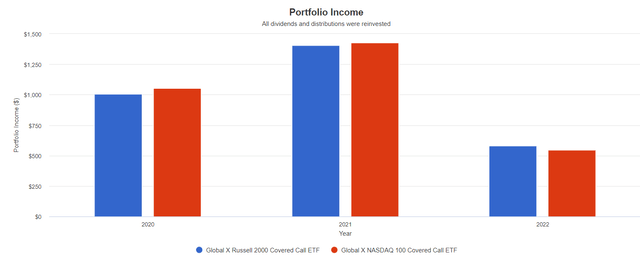
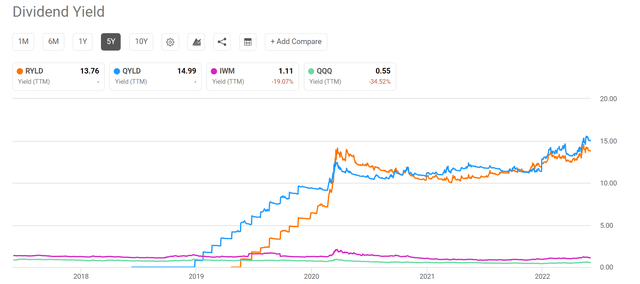
Advantage 2: attractive yield relative to treasury rates
Besides offering yields that are substantially above their underlying indices and also their historical averages, both funds are also yielding much higher than the risk-free treasury rates.
As detailed in our earlier writings,
For bond-like equity funds such as RYLD and QYLD that pay regular dividends, a major indicator I rely on (and fortunately with good success so far) has been the yield spread, i.e., the dividend yield minus the 10-year treasury bond yield. The spread also provides a measurement of the risk premium investors are paying. A large spread provides a higher margin of safety, and vice versa, therefore serving as a market timing indicator.
The following two charts show the yield spread between RYLD and QYLD against the 10-year treasury. The yield spread is calculated as their TTM dividend yield minus the 10-year Treasury bond rates. Due to the limited data available for RYLD, it’s difficult to establish a reliable trend. But as can be seen, the spread peaked around 13% in early 2020 (when the COVID panic was at its peak) and 10-year treasury rates dropped below 1%. The spread then bottomed around 9% in the middle of 2021 and has widened to the current level of almost 11% (10.85% to be exact). It is a level that is close to the peak level of its short historical level, signaling an attractive entry opportunity.
The yield spread for QYLD is shown in the second chart. And as you can see, its spread relative to the treasury rates is even more attractive. Thanks to its relatively long history, QYLD’s trend can be more reliably established. As you can see, its yield spread has been range-bound over the past 8 years. The yield spread has been fluctuating within a range between 7% to 10% most of the time. The current yield spread is at 12.1%, the highest level since its inception. Such a record yield spread signals an even more attractive entry opportunity compared to RYLD.
Source: author based on Seeking Alpha data Source: author based on Seeking Alpha data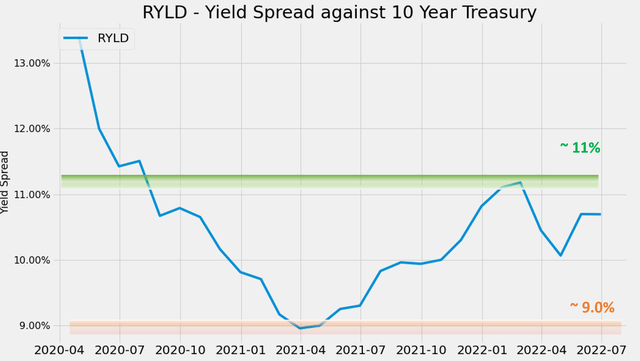
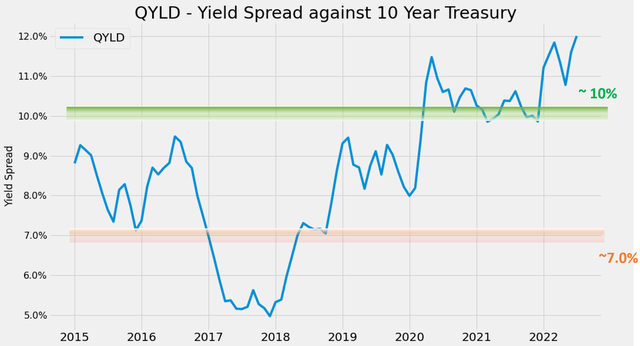
For readers familiar with our analyses, you know that the short-term returns are closely correlated with the yield spread for funds that pay regular dividends. The next chart shows the 1-year total return on RYLD (including price appreciation and dividend) regressed on yield spreads. Largely due to the limited data as aforementioned, the correlation has been nearly perfect with a Pearson correlation coefficient of 0.94. Particularly as shown in the orange box, when the spread is near the upper range of about 11% or higher as mentioned above, the total returns in the year have been all positive and very large (all above 30% and ranges up to ~50%+).
The picture for QYLD is very similar and is shown in the next chart. The plot is more scattered because of the more data points available for QYLD. But you can still clearly see the positive correlation with a Pearson correlation coefficient of 0.35. And again, as of this writing, the yield spreads between QYLD and risk-free rates is at 12.1%, the thickest level since its inception. Such a yield spread not only provides investors with appealing dividend income but also a thicker cushion against further rate uncertainties.
Source: author based on Seeking Alpha data Source: author based on Seeking Alpha data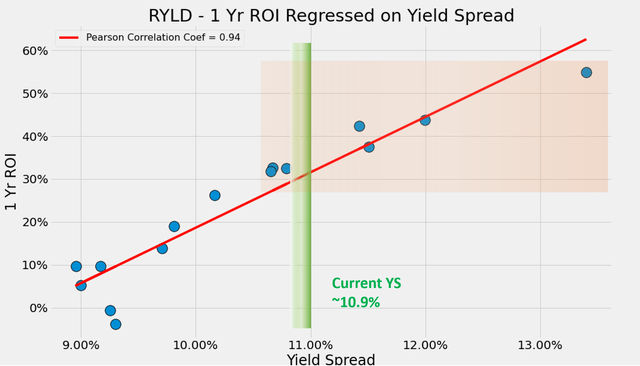
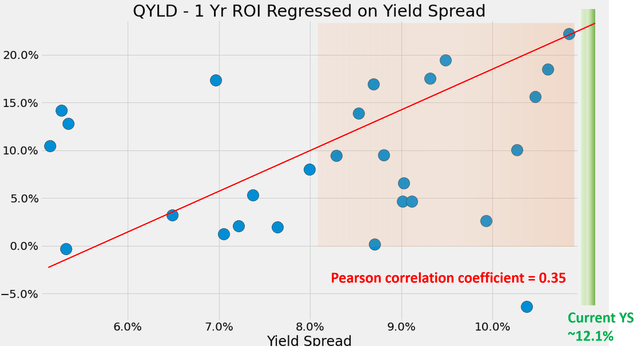
Disadvantage: built-in upside cap
Finally, the negatives. As the fund description disclosed, the use of covered-call options is at the price of forfeiting the upside appreciation. And such limitations are quite apparent in the following two charts, which compare RYLD and QYLD’s overall performance against their underlying (represented by IWM and QQQ, respectively).
As can be seen from the first chart, the overall return of RYLD has been 4.66% CAGR since 2020. And the IWM fund returned 5.86% CAGR, outperforming the RYLD fund by more than 100 bps per year. The second chart shows QYLD’s overall performance compared to its underlying QQQ. QYLD has returned 0.65% CAGR since 2020. And in contrast, QQQ returned more than 17%, an even larger performance gap. You can also see that QQQ has been consistently outperforming QYLD in this whole period despite the recent large corrections.
The fundamental reasons are as aforementioned:
Selling a call is a strategy that has a limited upside built-in at the root level. The gain from the call writing was fixed – no matter how the price of the underlying appreciates.
Portfolio Visualizer, Silicon Cloud Technologies LLC Portfolio Visualizer, Silicon Cloud Technologies LLC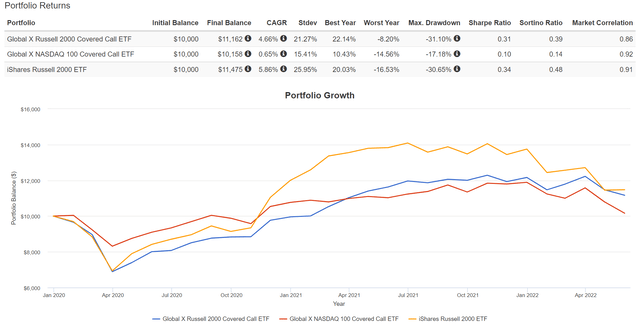
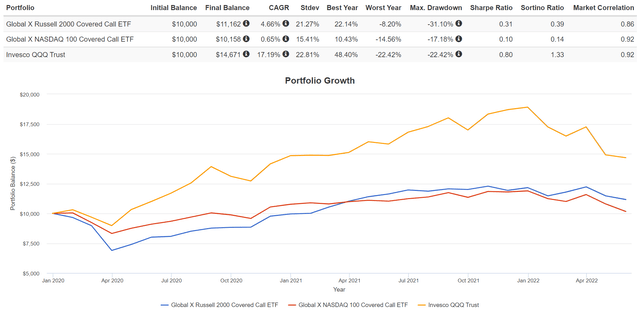
Final thoughts and other risks
Both RYLD and QYLD follow a similar covered call strategy to generate income at an attractive level and on a monthly basis. The key takeaway is that now is an attractive time to consider both of them for the following reasons:
- Both of them offer dividend yields that are far above the historical average and also above treasury rates.
- Especially for QYLD, its yield spread is 12.1% above 10-year treasury rates, the highest level since its inception about 8 years ago. To me, this signals a more attractive entry opportunity than RYLD.
Finally, risks. As aforementioned, the call-writing strategy limits total returns and can cause lag compared to the underlying index in the long term, a key points for investors to consider based on their investing goal and timeframe.
Despite the fact that call-options tend to generate higher premiums during increased market volatility, both RYLD and QYLD have suffered substantial volatility risks. As you can see from the two charts above, QYLD suffered a maximum drawdown of 17.2% since 2020. Compared to QQQ’s 22.4%, it is admittedly a bit smaller, but still sizable in absolute terms. In the case of RYLD, it suffered a maximum drawdown of 31.1% since 2020. Compared to IWM’s 30.6%, it was actually a bit higher.
Finally, given the above volatility risks, conservative investors may consider combing their use with other asset classes such as gold and treasury bonds for the following reasons detailed in my earlier articles A) the treasury rates almost reached the long-term goal already and the downside is limited now, B) gold effectively hedges against market turmoil and negative interest rates, and C) RYLD and QYLD have demonstrated negative correlation or low correlation against gold and treasury bonds.
[ad_2]
Source links Google News

